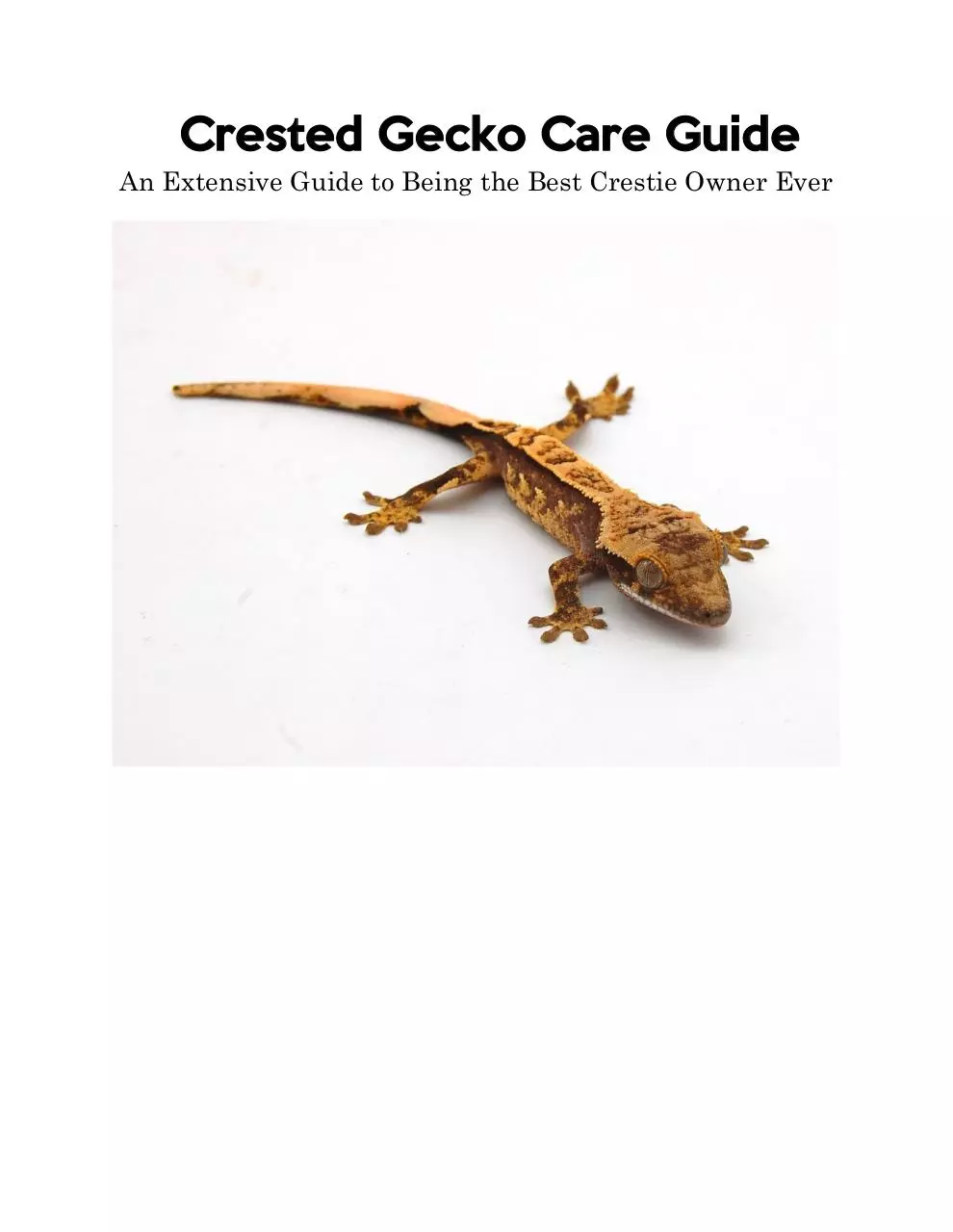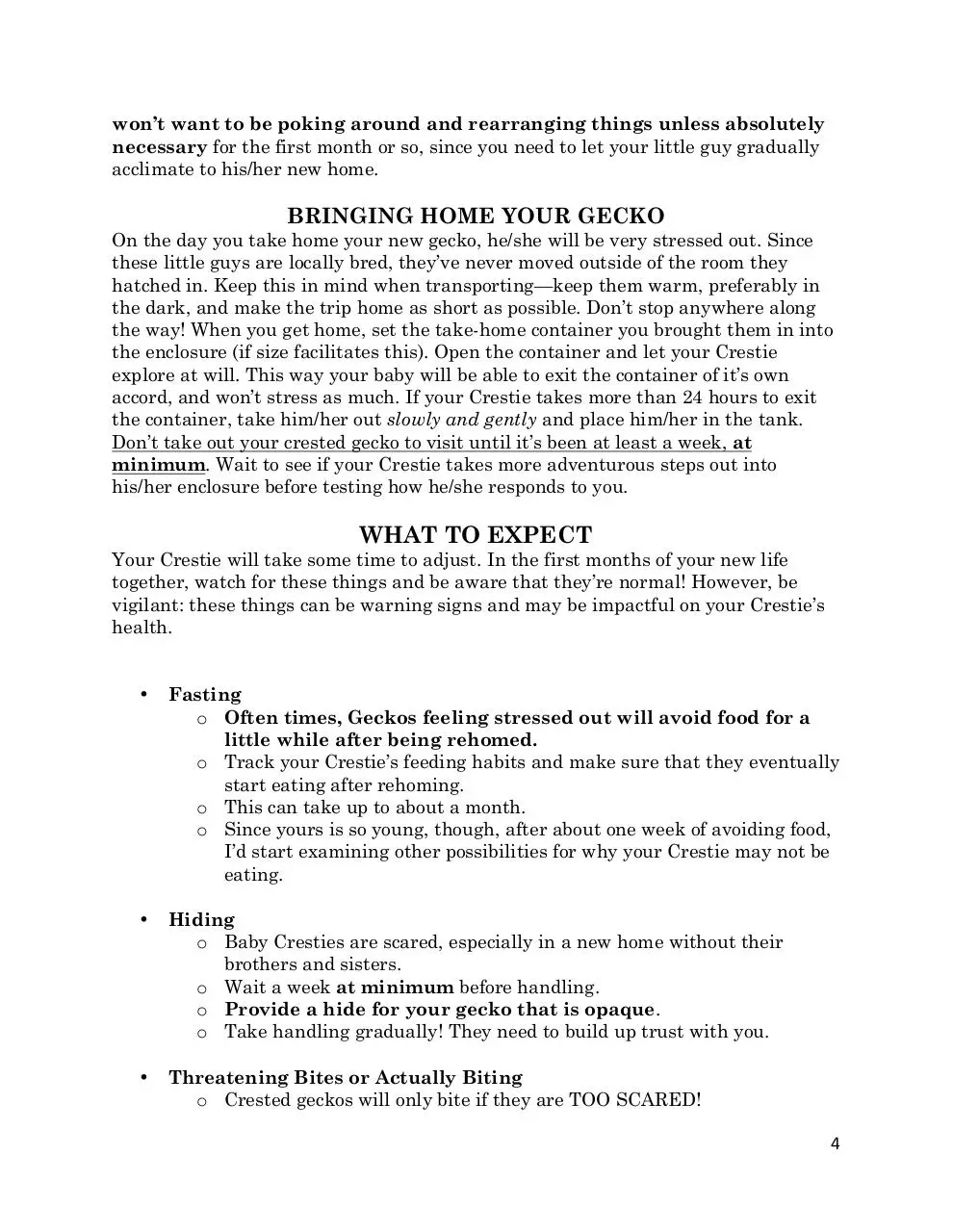Crested Gecko Care Sheet (PDF)
File information
Title: Microsoft Word - Crested Gecko Care Sheet.docx
This PDF 1.3 document has been generated by Word / Mac OS X 10.11.3 Quartz PDFContext, and has been sent on pdf-archive.com on 18/02/2016 at 23:47, from IP address 174.50.x.x.
The current document download page has been viewed 988 times.
File size: 500.43 KB (15 pages).
Privacy: public file





File preview
Crested Gecko Care Guide
An Extensive Guide to Being the Best Crestie Owner Ever
INDEX
Background Information Disclaimer, & Life Guarantee.……………………………..…3
Pre-Crestie Preparation & Early Behaviors…………………………………….……….4-5
Socializing……………………………………………………………………………………….6
Food…………………………………………………………………………………………....6-8
Housing………………………………………………………………………………………7-10
Health Issues & Veterinarians…………………………………………………………10-13
My Favorite Pet Stores………………………………………………………………………14
Resources & References…………………………………………………………….………..13
Checklists………………………………………………………………………………………14
Summary……………………………………………………………………………….………15
2
BACKGROUND INFORMATION
Scientific Name:
Place of Origin:
Gecko Hatch Date(s):
Lifespan:
Correlophus ciliatus
New Caledonia
15-20 years
Crested Geckos are a mid to high humidity, upper room temperature lizard that
needs to eat both fruit (in captivity, it’s meal replacement powder) and bugs like
Crickets, Dubias, and Meal Worms. They are friendly, fun, and beautiful to look at.
They change colors, (flame up) and get brighter and darker depending on their
mood, alertness, humidity, temperature and other variables. One day your Crestie
may be all one, muted, tone, and the next you have a bright Harlequin color
mutation! They also have special sticky feet pads and a prehensile tail with a sticky
pad at the end. These pads are hydrophilic, and when used in combination with
what is essentially static cling, they become excellent climbers. Cresties are easy to
care for… if you are observant and thoughtful when choosing your method of care.
Everyone cares for their pets a little differently. Make sure you always watch your
Crestie to see how he or she may respond to new or different environmental stimuli.
HEALTH GUARANTEE
Because I believe that I have the knowledge, skill, and diligence required to breed
happy, healthy Crested Geckos, I will guarantee the life of your gecko for 14 days
after you take him/her home. This means that you are responsible for taking
him/her to the vet if they should appear sick… If your gecko should die within two
weeks, I will give you a second gecko if and only if you can prove to me that the
quality of the enclosure was up to par and you made every possible effort to keep
your little one healthy.
PREPARING FOR YOUR GECKO
Before you take home your Gecko, make sure you know what you’re in for. Though
Crested Geckos are known as a hardier, easier to care for animal than a lot of other
reptiles, make sure you’re prepared for the baby before it gets home. Babies are a
lot more sensitive to change and aren’t nearly as hardy as adults! Have your
entire enclosure set up and ready to go. Make sure you’ve checked (and double
checked) the ambient room temperature and made necessary lighting/heating
adjustments to match those listed as acceptable on this care sheet. Make sure the
enclosure won’t need any new adjustments right after you put your gecko in it. You
3
won’t want to be poking around and rearranging things unless absolutely
necessary for the first month or so, since you need to let your little guy gradually
acclimate to his/her new home.
BRINGING HOME YOUR GECKO
On the day you take home your new gecko, he/she will be very stressed out. Since
these little guys are locally bred, they’ve never moved outside of the room they
hatched in. Keep this in mind when transporting—keep them warm, preferably in
the dark, and make the trip home as short as possible. Don’t stop anywhere along
the way! When you get home, set the take-home container you brought them in into
the enclosure (if size facilitates this). Open the container and let your Crestie
explore at will. This way your baby will be able to exit the container of it’s own
accord, and won’t stress as much. If your Crestie takes more than 24 hours to exit
the container, take him/her out slowly and gently and place him/her in the tank.
Don’t take out your crested gecko to visit until it’s been at least a week, at
minimum. Wait to see if your Crestie takes more adventurous steps out into
his/her enclosure before testing how he/she responds to you.
WHAT TO EXPECT
Your Crestie will take some time to adjust. In the first months of your new life
together, watch for these things and be aware that they’re normal! However, be
vigilant: these things can be warning signs and may be impactful on your Crestie’s
health.
•
Fasting
o Often times, Geckos feeling stressed out will avoid food for a
little while after being rehomed.
o Track your Crestie’s feeding habits and make sure that they eventually
start eating after rehoming.
o This can take up to about a month.
o Since yours is so young, though, after about one week of avoiding food,
I’d start examining other possibilities for why your Crestie may not be
eating.
•
Hiding
o Baby Cresties are scared, especially in a new home without their
brothers and sisters.
o Wait a week at minimum before handling.
o Provide a hide for your gecko that is opaque.
o Take handling gradually! They need to build up trust with you.
•
Threatening Bites or Actually Biting
o Crested geckos will only bite if they are TOO SCARED!
4
o Put back your baby if it starts to bite or act like it will.
o Crestie bites don’t hurt, so don’t be afraid!
o As your Crestie gets older, it may use biting as a tactic to get put back
in it’s tank. If you want a social, adult Crestie, be prepared to let
it bite you. This will teach it that it won’t get to go home just because
it’s feeling feisty.
•
Jumping
o Your Crestie will always jump, it’s part of it’s nature.
o Attempting to catch your Crestie in mid air will often times
lead to accidentally swatting it out of the air.
o A Crestie can take a fall—if it jumps, it’s usually a good idea to let it
fall before picking it up. It’s never worth risking swatting him/her out
of the air!
o The more nervous your Crestie is, the more it will jump. If it jumps
over and over again, try putting it back and trying again in a day or
two.
•
Shedding
o Geckos shed more frequently when they’re young since they grow more
o Colors will become muted and they will have a harder time sticking to
things with their feet and tail before a shed
o Don’t feed crickets before a shed! This can be a hazard of Cricket
aggression AND impaction, ESPECIALLY for a baby!
o Cresties are known to eat their shed! If it looks like your Crestie has
more color but you can’t find his/her shed, they probably ate it.
o SHED CAN GET STUCK AND CAUSE SERIOUS HEALTH
ISSUES!!! Be wary of this especially with your baby!
§ Low temperature or humidity can cause shedding problemsRaise humidity a bit to aid shedding.
§ Your Crestie can lose a finger, hand, or even tail to this
issue!
§ See the “health issues” section for more information and how to
help your Crestie get off stuck shed.
SOCIALIZING
Once your baby has fully acclimated to his or her tank setup, please be patient
when beginning to handle him/her. Handle your Crestie with care and consideration
for his/her stress level. Start out handling 3-5 minutes a day and gradually
increasing, eventually your Crestie will feel comfortable enough to literally lick
baby food off your hand, or snatch a cricket from your forceps!
Remember, as a high humidity animal in the desert, your Crestie will immediately
feel the humidity change as you handle him/her. This means that you won’t be able
5
to take him or her out with you, because you don’t want your Crestie getting
dehydrated or stressed. Among various other life-threatening dangers, this one is
almost the least of the problems you’d encounter trying to bring your Crestie with
you to a coffee shop!
Remember that your Crestie is nocturnal, and might be more fun to hang
out with at night or in a low-light setting. The dark is easier for them to see in,
and their pupils grow to almost the size of their whole eye in the dark! Don’t worry,
this is normal. Your Crestie is not using drugs! (Whew)
FOOD
Repashy (Main Diet)
Repashy was made by Allen Repashy and is widely-accepting in the local and
online herpetological community as the cornerstone diet for a Crested Gecko. I
would not recommend any other food as your Crestie’s main food source. Why? This
diet is perfectly fitted to meet the dietary needs of your Crestie! It’s the healthiest,
yummiest, and easiest to feed MRP (meal replacement powder) out there. It’s
always available in pet stores and it smells like fruit. It’s going to be the best way to
keep your little one healthy.
Frequency: As hatchlings to 2-4 month olds, I feed this MRP to my Cresties daily.
They will not eat it all. However, due to the possibility that small changes can
stress out a baby Crestie, I find it’s best to keep a steady supply for the babies. If
they get full, they simply won’t eat. After that, feed Repashy 3-4 times a week.
Stagger these days with the 1-2x a week you feed dusted crickets.
Remember: Your
Crestie can become
dehydrated easily if
you mix the food too
thick! Stick to the
2:1 water to powder
ratio, and you
should get a
ketchup-y like
consistency.
will spoil.
Repashy, continued
To Mix: Dilute the Repashy powder with twice as much
water. Don’t make the food too hot, or they won’t eat it.
Consider that 80° is too hot for a Crestie. If your internal
temperature is about 98.8°, if it feels warm to your finger,
it’s probably too warm for them. I put ½ the water warm in
first, mix the clumps out, and add the other ½ of the water
in cold. This way you can still mix all the clumps out
before cooling down the mixture. Repashy cannot keep
for more than one day. Put the food in their tank at
night, and the next afternoon or night take it out. It
6
Crickets (Supplemented with Calcium)
Dust crickets with a supplemental calcium (and even gut load them with
cricket gut loader) before feeding them to your Crestie. Feed small size crickets to
start out, and about 3-6 depending on the appetite of your Crestie. If they want
more, feed a few more. However, overfeeding crickets & bugs can become a
health issue for your Crestie if it happens too frequently. I only feed my
geckos crickets once a week. I would only feed them two times per week at
maximum. Take out left over crickets, alive and dead. Living crickets can
gang up on and try to eat your Crestie, causing injury. Dead crickets rot
and smell awful!
Dubias (Also Supplemented with Calcium)
Dubias are a small roach that doesn’t really look like a roach. These are
much healthier than crickets and are a suitable replacement for crickets
in the diet of your Crestie! They are a bit more expensive, and sometimes hard to
find. They can’t climb glass, so they’re easier to contain, but they do burrow.
Sometimes Cresties wont immediately start eating Dubias if they have already been
fed a cricket. If you think of Crickets as a snickers bar, Dubias are a filet mignon! If
you can, I highly recommend feeding Dubias in place of Crickets. You will still
want to dust Dubias with Calcium powder, just like you would with
Crickets. Plenty of pet stores carry Dubias as well as Crickets.
Treats
Treats can include waxworms and other bugs,
Don’t ever feed your
or fruit or organic, all-natural, additive free baby
Crestie a bug off the
foods. (Make sure you check that the ingredients are
floor! Crested Geckos
only fruit and water!)
can get parasites and
Feeding waxworms is fatty, and should only be
other health issues
done every few days or weeks. Waxworms can
from bugs you pick up
potentially bite your Crestie and even eat their
off the ground.
way out through the stomach of your baby!
Make sure you always crush or cut off the heads of
these guys so they don’t cause any harm to your Crestie.
Because even all-natural, organic baby food does not contain the proper
calcium to vitamin D3 proportion, only feed baby food as a treat. Make sure you
are buying Repashy as the main food source.
Don’t feed your Crested Gecko any mealworms or superworms! They
are too rich in Chitin for your little guy. Waxworms are okay occasionally.
HOUSING
Housing is absolutely essential to the well being of your baby. This is going to be the
most expensive part of your new pet going forward, but a good tank means a happy
and healthy Crestie! Don’t skimp on these things, they are just as important to the
wellbeing of the Crestie as are food and water!
7
Crested Geckos are an arboreal lizard. This means they climb and hide up in the
trees. They need a TALL, not LONG tank! Look at Zoo Med and Exo Terra’s line of
tall tanks, these suit Crested Geckos of all sizes.
At 2 months, a Crestie will do fine in a medium to large critter keeper. As it grows,
you will want to continually size up the tank. When they’re fully grown, the bigger
the better!! The minimum tank size for a full grown Crestie is about 10 gallons.
Check out Exo Terra’s 12x12x19 (Mini Tall) tank which is about 10 gallons. If you
have more than one Crestie you will need a bigger tank.
Hiding & Sleeping
Crested Geckos are nocturnal. Since they like to sleep all day, give them a
nice hide to sleep in. They won’t always choose to sleep in their designated
place. This doesn’t mean they don’t appreciate it! For babies, you can use
small tarantula hides, or ones meant for other types of lizards. Later, you can
use those fancy magnetic hides that stick to the side of the tank—this way
they can sleep up high if they want!
Hides are essential to the emotional wellbeing of your little one. If they don’t
have a place to run away and feel safe, they may get over stressed and
subsequently unhealthy.
Climbing
Use vines and fake plants to allow your Crestie to climb and jump away! This
is essential because they are arboreal and in nature will spend all day in the
trees. If you’re ambitious, you can live-plant a vivarium for your gecko! This
takes a LOT more time, money and effort, but is worth it if you’re wanting a
highly aesthetically pleasing tank. Look up internet tutorials on how to live
plant a Crested Gecko tank. Make sure the plants you use are safe for
the geckos and require similar humidity & temperature levels, so you don’t
kill one trying to nurture the other.
Water & Humidity
Cresties absolutely need to be sprayed down every single night. Make sure
you get the sides of the tank; Cresties love to lick the water off the glass and
are less likely to drink out of a dish. Always use a dish, too. More than once
I’ve caught my adults bathing and drinking from the dish. In our climate, it’s
never too much! Change the dish water daily.
8
Cresties need a humidity fluctuation throughout the day. Allow them to
get more dry over the course of the day, then wet them down really well at night.
Monitor the humidity to make sure it doesn’t get below about 30% at the driest
point. At night it can be sprayed to about 80%. You can use a spray bottle or mister
to spray them down. I wouldn’t recommend a Repti-fogger; those are only fog and
don’t have enough condensation that the Cresties will lick water off the sides of the
tank. Be thinking about how you plan to keep your Crestie humid enough,
especially when it’s shedding time! Sometimes it gets dry enough that they
need to be sprayed down multiple times a day.
Temperature
In the daytime, temperature should be between 75-80° and
can drop to low 70s at night. In winter, temperatures at
night can drop to high 60s. A ceramic heat emitter or lowwattage, blue color incandescent bulb can provide heat if
needed. Usually a room temperature room will suffice and
you won’t need any additionally heating or lighting. If you
do get a heater of any type, make sure your Crestie
has a thermal gradient so he/she can choose their
temperature. Usually a Crestie will be careful of heat but
to be safe place the heat source far enough away
from the tank that the Crestie cannot burn itself on
the heat source or screen.
A Clean Crestie is a
Happy Crestie!
Crestie poop is stiiinky
and quickly can degrade
your little guy’s air
quality! Do regular poop
pick ups, change
substrate regularly and
clean off all tank
ornaments that get
pooped on!
9
Download Crested Gecko Care Sheet
Crested Gecko Care Sheet.pdf (PDF, 500.43 KB)
Download PDF
Share this file on social networks
Link to this page
Permanent link
Use the permanent link to the download page to share your document on Facebook, Twitter, LinkedIn, or directly with a contact by e-Mail, Messenger, Whatsapp, Line..
Short link
Use the short link to share your document on Twitter or by text message (SMS)
HTML Code
Copy the following HTML code to share your document on a Website or Blog
QR Code to this page

This file has been shared publicly by a user of PDF Archive.
Document ID: 0000341012.